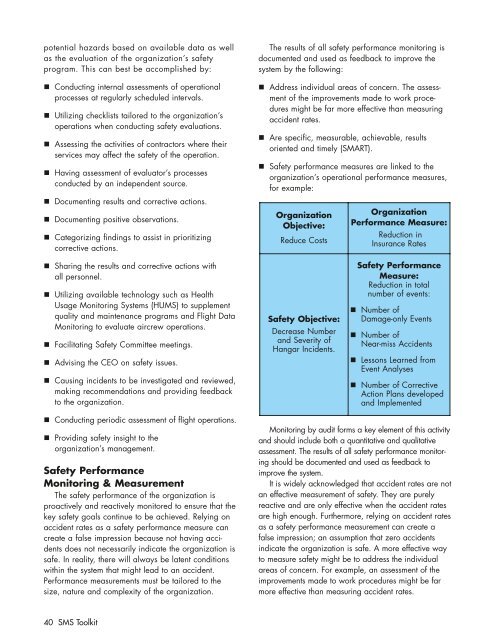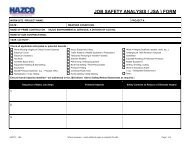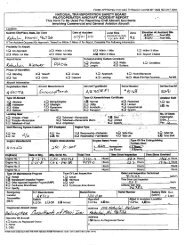International Helicopter Safety Team Safety Management System Toolkit
IHST - Safety Management Toolkit - Skybrary
IHST - Safety Management Toolkit - Skybrary
- No tags were found...
Create successful ePaper yourself
Turn your PDF publications into a flip-book with our unique Google optimized e-Paper software.
potential hazards based on available data as well<br />
as the evaluation of the organization’s safety<br />
program. This can best be accomplished by:<br />
Conducting internal assessments of operational<br />
processes at regularly scheduled intervals.<br />
Utilizing checklists tailored to the organization’s<br />
operations when conducting safety evaluations.<br />
Assessing the activities of contractors where their<br />
services may affect the safety of the operation.<br />
Having assessment of evaluator’s processes<br />
conducted by an independent source.<br />
Documenting results and corrective actions.<br />
Documenting positive observations.<br />
Categorizing findings to assist in prioritizing<br />
corrective actions.<br />
The results of all safety performance monitoring is<br />
documented and used as feedback to improve the<br />
system by the following:<br />
Address individual areas of concern. The assessment<br />
of the improvements made to work procedures<br />
might be far more effective than measuring<br />
accident rates.<br />
Are specific, measurable, achievable, results<br />
oriented and timely (SMART).<br />
<strong>Safety</strong> performance measures are linked to the<br />
organization’s operational performance measures,<br />
for example:<br />
Organization<br />
Objective:<br />
Reduce Costs<br />
Organization<br />
Performance Measure:<br />
Reduction in<br />
Insurance Rates<br />
Sharing the results and corrective actions with<br />
all personnel.<br />
Utilizing available technology such as Health<br />
Usage Monitoring <strong>System</strong>s (HUMS) to supplement<br />
quality and maintenance programs and Flight Data<br />
Monitoring to evaluate aircrew operations.<br />
Facilitating <strong>Safety</strong> Committee meetings.<br />
Advising the CEO on safety issues.<br />
Causing incidents to be investigated and reviewed,<br />
making recommendations and providing feedback<br />
to the organization.<br />
<strong>Safety</strong> Objective:<br />
Decrease Number<br />
and Severity of<br />
Hangar Incidents.<br />
<strong>Safety</strong> Performance<br />
Measure:<br />
Reduction in total<br />
number of events:<br />
Number of<br />
Damage-only Events<br />
Number of<br />
Near-miss Accidents<br />
Lessons Learned from<br />
Event Analyses<br />
Number of Corrective<br />
Action Plans developed<br />
and Implemented<br />
Conducting periodic assessment of flight operations.<br />
Providing safety insight to the<br />
organization’s management.<br />
<strong>Safety</strong> Performance<br />
Monitoring & Measurement<br />
The safety performance of the organization is<br />
proactively and reactively monitored to ensure that the<br />
key safety goals continue to be achieved. Relying on<br />
accident rates as a safety performance measure can<br />
create a false impression because not having accidents<br />
does not necessarily indicate the organization is<br />
safe. In reality, there will always be latent conditions<br />
within the system that might lead to an accident.<br />
Performance measurements must be tailored to the<br />
size, nature and complexity of the organization.<br />
Monitoring by audit forms a key element of this activity<br />
and should include both a quantitative and qualitative<br />
assessment. The results of all safety performance monitoring<br />
should be documented and used as feedback to<br />
improve the system.<br />
It is widely acknowledged that accident rates are not<br />
an effective measurement of safety. They are purely<br />
reactive and are only effective when the accident rates<br />
are high enough. Furthermore, relying on accident rates<br />
as a safety performance measurement can create a<br />
false impression; an assumption that zero accidents<br />
indicate the organization is safe. A more effective way<br />
to measure safety might be to address the individual<br />
areas of concern. For example, an assessment of the<br />
improvements made to work procedures might be far<br />
more effective than measuring accident rates.<br />
40 SMS <strong>Toolkit</strong>







